BMO6630 Business Research Methods: Survey Administration & Improvement
VerifiedAdded on 2023/06/03
|8
|2032
|489
Report
AI Summary
This report details the administration of a survey using the group administration method, focusing on collecting qualitative data from respondents who are regular travelers and purchasers of luxury goods. It discusses the reasons for choosing this method, its advantages (accurate data representation, low costs, reduced bias), and disadvantages (inflexibility, unsuitability for controversial topics, potential for inappropriate questions). The report also assesses the success rate based on population size and respondent burden, suggesting improvements such as pre-survey notifications, personal delivery, and cover letters. Key changes for administering the questionnaire to a larger group include reducing respondent burden and ensuring question appropriateness. The author reflects on lessons learned, emphasizing the importance of standardized and appropriate questions. The report concludes that group administration is suitable for this research, provided attention is paid to questionnaire length and question appropriateness. Desklib provides similar solved assignments for students.
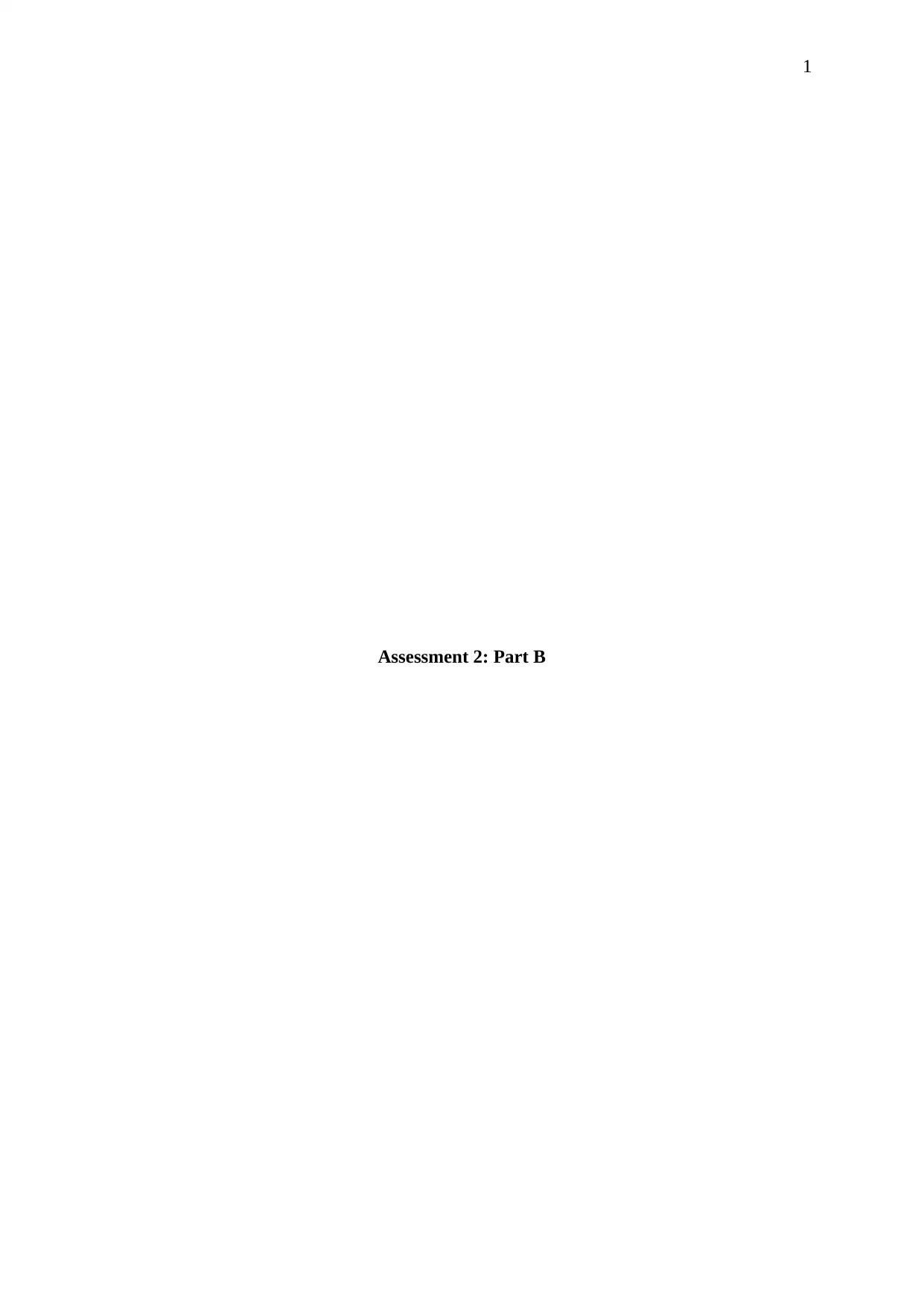
1
Assessment 2: Part B
Assessment 2: Part B
Paraphrase This Document
Need a fresh take? Get an instant paraphrase of this document with our AI Paraphraser
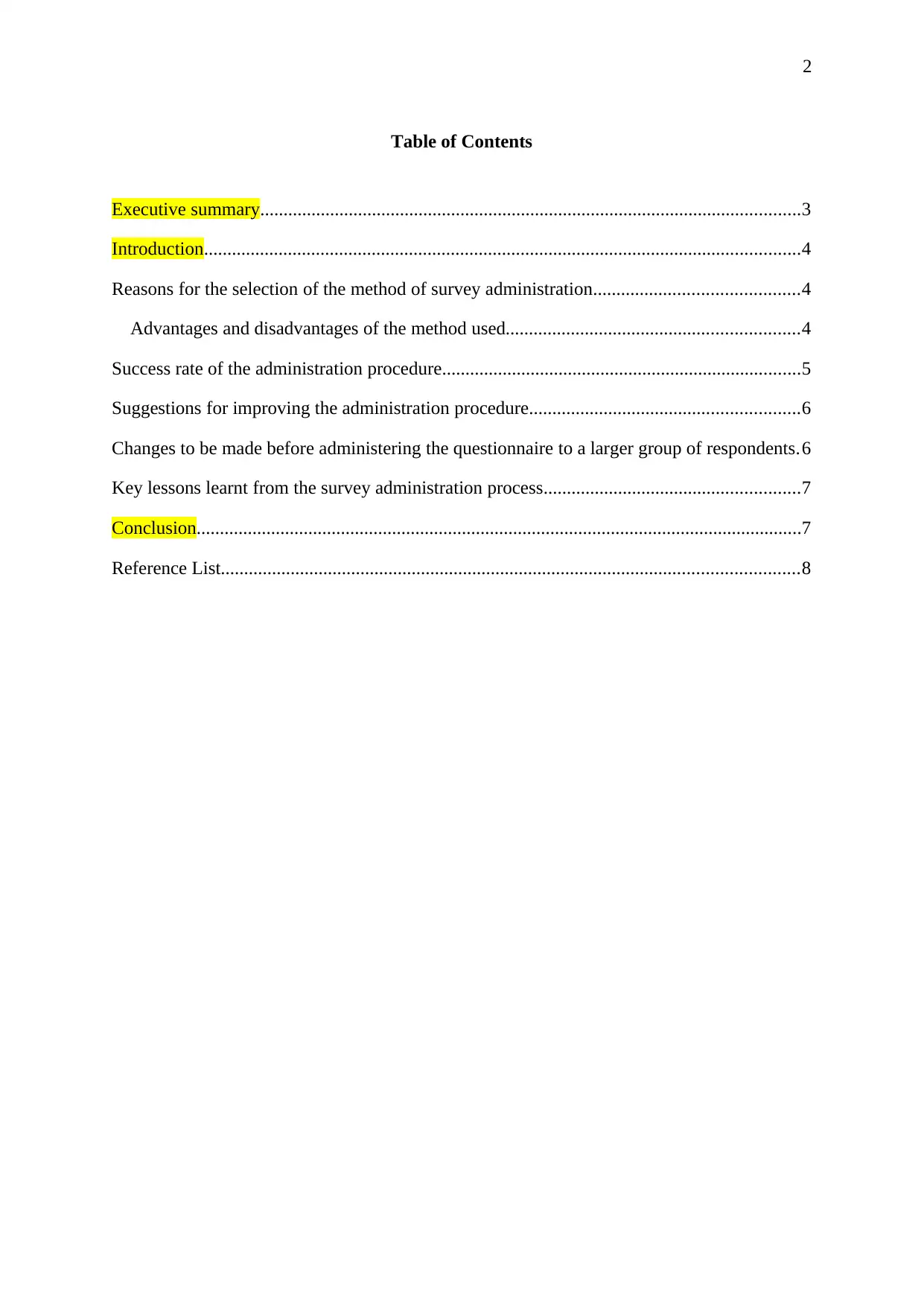
2
Table of Contents
Executive summary....................................................................................................................3
Introduction................................................................................................................................4
Reasons for the selection of the method of survey administration............................................4
Advantages and disadvantages of the method used...............................................................4
Success rate of the administration procedure.............................................................................5
Suggestions for improving the administration procedure..........................................................6
Changes to be made before administering the questionnaire to a larger group of respondents.6
Key lessons learnt from the survey administration process.......................................................7
Conclusion..................................................................................................................................7
Reference List............................................................................................................................8
Table of Contents
Executive summary....................................................................................................................3
Introduction................................................................................................................................4
Reasons for the selection of the method of survey administration............................................4
Advantages and disadvantages of the method used...............................................................4
Success rate of the administration procedure.............................................................................5
Suggestions for improving the administration procedure..........................................................6
Changes to be made before administering the questionnaire to a larger group of respondents.6
Key lessons learnt from the survey administration process.......................................................7
Conclusion..................................................................................................................................7
Reference List............................................................................................................................8
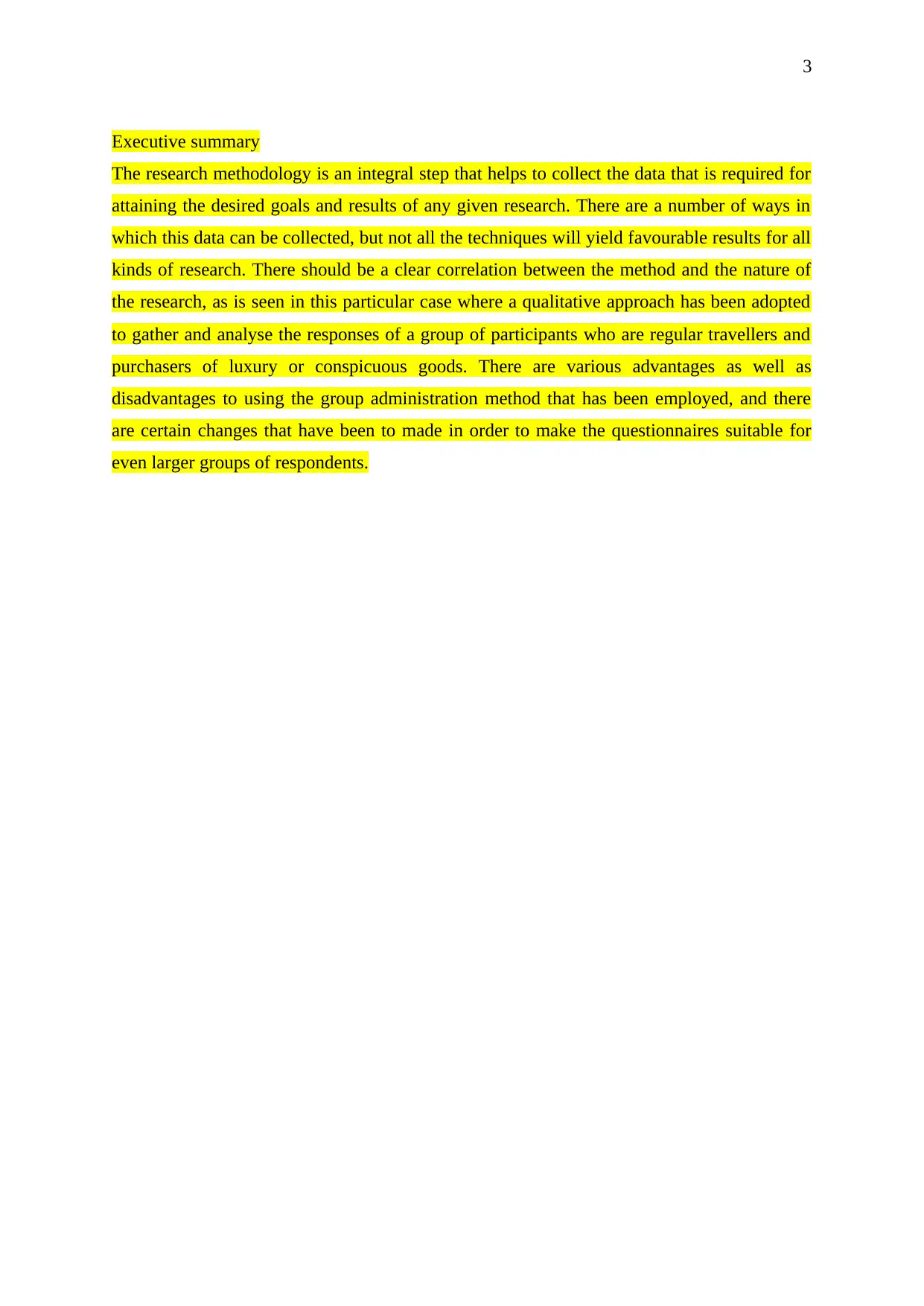
3
Executive summary
The research methodology is an integral step that helps to collect the data that is required for
attaining the desired goals and results of any given research. There are a number of ways in
which this data can be collected, but not all the techniques will yield favourable results for all
kinds of research. There should be a clear correlation between the method and the nature of
the research, as is seen in this particular case where a qualitative approach has been adopted
to gather and analyse the responses of a group of participants who are regular travellers and
purchasers of luxury or conspicuous goods. There are various advantages as well as
disadvantages to using the group administration method that has been employed, and there
are certain changes that have been to made in order to make the questionnaires suitable for
even larger groups of respondents.
Executive summary
The research methodology is an integral step that helps to collect the data that is required for
attaining the desired goals and results of any given research. There are a number of ways in
which this data can be collected, but not all the techniques will yield favourable results for all
kinds of research. There should be a clear correlation between the method and the nature of
the research, as is seen in this particular case where a qualitative approach has been adopted
to gather and analyse the responses of a group of participants who are regular travellers and
purchasers of luxury or conspicuous goods. There are various advantages as well as
disadvantages to using the group administration method that has been employed, and there
are certain changes that have been to made in order to make the questionnaires suitable for
even larger groups of respondents.
⊘ This is a preview!⊘
Do you want full access?
Subscribe today to unlock all pages.

Trusted by 1+ million students worldwide
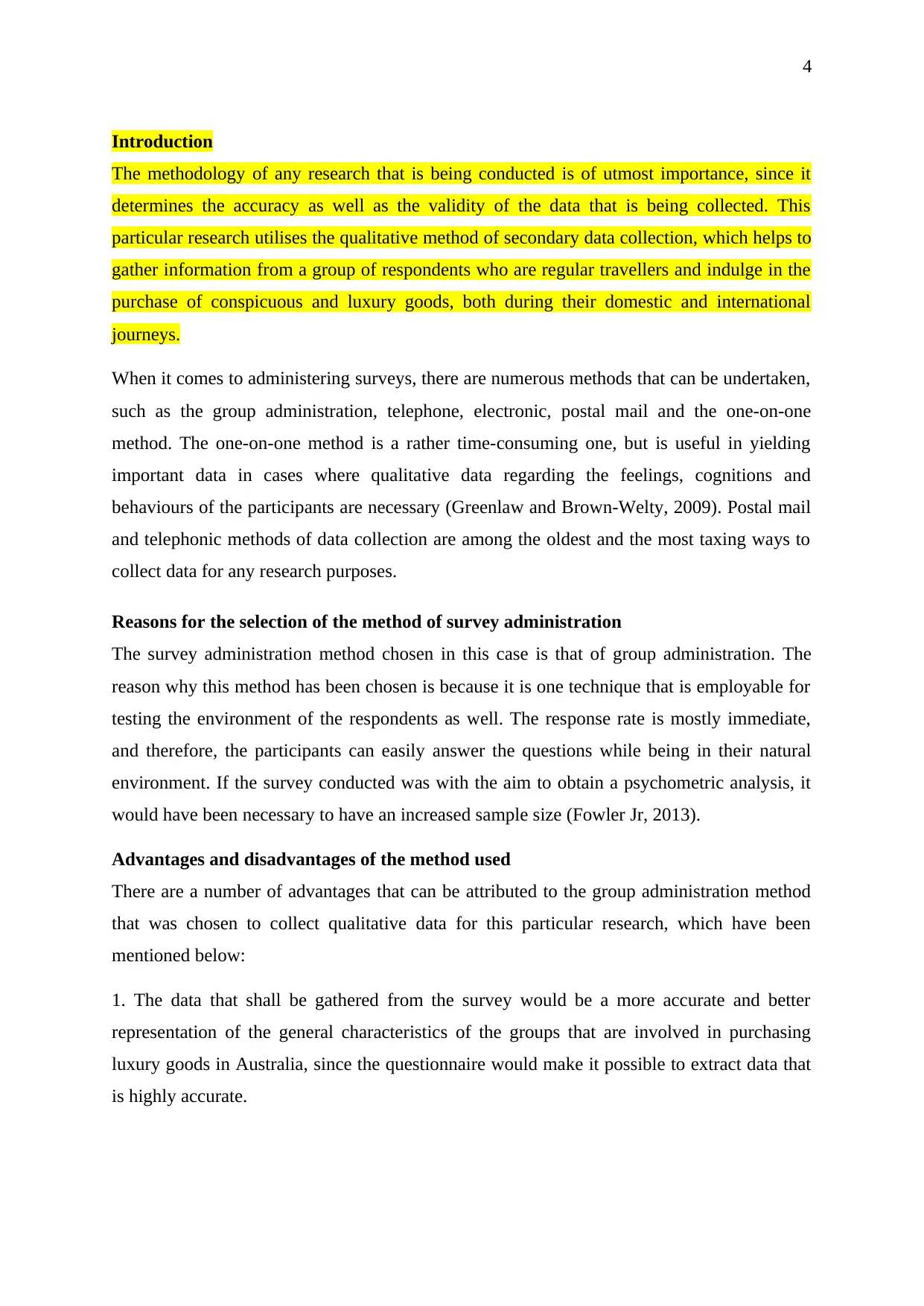
4
Introduction
The methodology of any research that is being conducted is of utmost importance, since it
determines the accuracy as well as the validity of the data that is being collected. This
particular research utilises the qualitative method of secondary data collection, which helps to
gather information from a group of respondents who are regular travellers and indulge in the
purchase of conspicuous and luxury goods, both during their domestic and international
journeys.
When it comes to administering surveys, there are numerous methods that can be undertaken,
such as the group administration, telephone, electronic, postal mail and the one-on-one
method. The one-on-one method is a rather time-consuming one, but is useful in yielding
important data in cases where qualitative data regarding the feelings, cognitions and
behaviours of the participants are necessary (Greenlaw and Brown-Welty, 2009). Postal mail
and telephonic methods of data collection are among the oldest and the most taxing ways to
collect data for any research purposes.
Reasons for the selection of the method of survey administration
The survey administration method chosen in this case is that of group administration. The
reason why this method has been chosen is because it is one technique that is employable for
testing the environment of the respondents as well. The response rate is mostly immediate,
and therefore, the participants can easily answer the questions while being in their natural
environment. If the survey conducted was with the aim to obtain a psychometric analysis, it
would have been necessary to have an increased sample size (Fowler Jr, 2013).
Advantages and disadvantages of the method used
There are a number of advantages that can be attributed to the group administration method
that was chosen to collect qualitative data for this particular research, which have been
mentioned below:
1. The data that shall be gathered from the survey would be a more accurate and better
representation of the general characteristics of the groups that are involved in purchasing
luxury goods in Australia, since the questionnaire would make it possible to extract data that
is highly accurate.
Introduction
The methodology of any research that is being conducted is of utmost importance, since it
determines the accuracy as well as the validity of the data that is being collected. This
particular research utilises the qualitative method of secondary data collection, which helps to
gather information from a group of respondents who are regular travellers and indulge in the
purchase of conspicuous and luxury goods, both during their domestic and international
journeys.
When it comes to administering surveys, there are numerous methods that can be undertaken,
such as the group administration, telephone, electronic, postal mail and the one-on-one
method. The one-on-one method is a rather time-consuming one, but is useful in yielding
important data in cases where qualitative data regarding the feelings, cognitions and
behaviours of the participants are necessary (Greenlaw and Brown-Welty, 2009). Postal mail
and telephonic methods of data collection are among the oldest and the most taxing ways to
collect data for any research purposes.
Reasons for the selection of the method of survey administration
The survey administration method chosen in this case is that of group administration. The
reason why this method has been chosen is because it is one technique that is employable for
testing the environment of the respondents as well. The response rate is mostly immediate,
and therefore, the participants can easily answer the questions while being in their natural
environment. If the survey conducted was with the aim to obtain a psychometric analysis, it
would have been necessary to have an increased sample size (Fowler Jr, 2013).
Advantages and disadvantages of the method used
There are a number of advantages that can be attributed to the group administration method
that was chosen to collect qualitative data for this particular research, which have been
mentioned below:
1. The data that shall be gathered from the survey would be a more accurate and better
representation of the general characteristics of the groups that are involved in purchasing
luxury goods in Australia, since the questionnaire would make it possible to extract data that
is highly accurate.
Paraphrase This Document
Need a fresh take? Get an instant paraphrase of this document with our AI Paraphraser
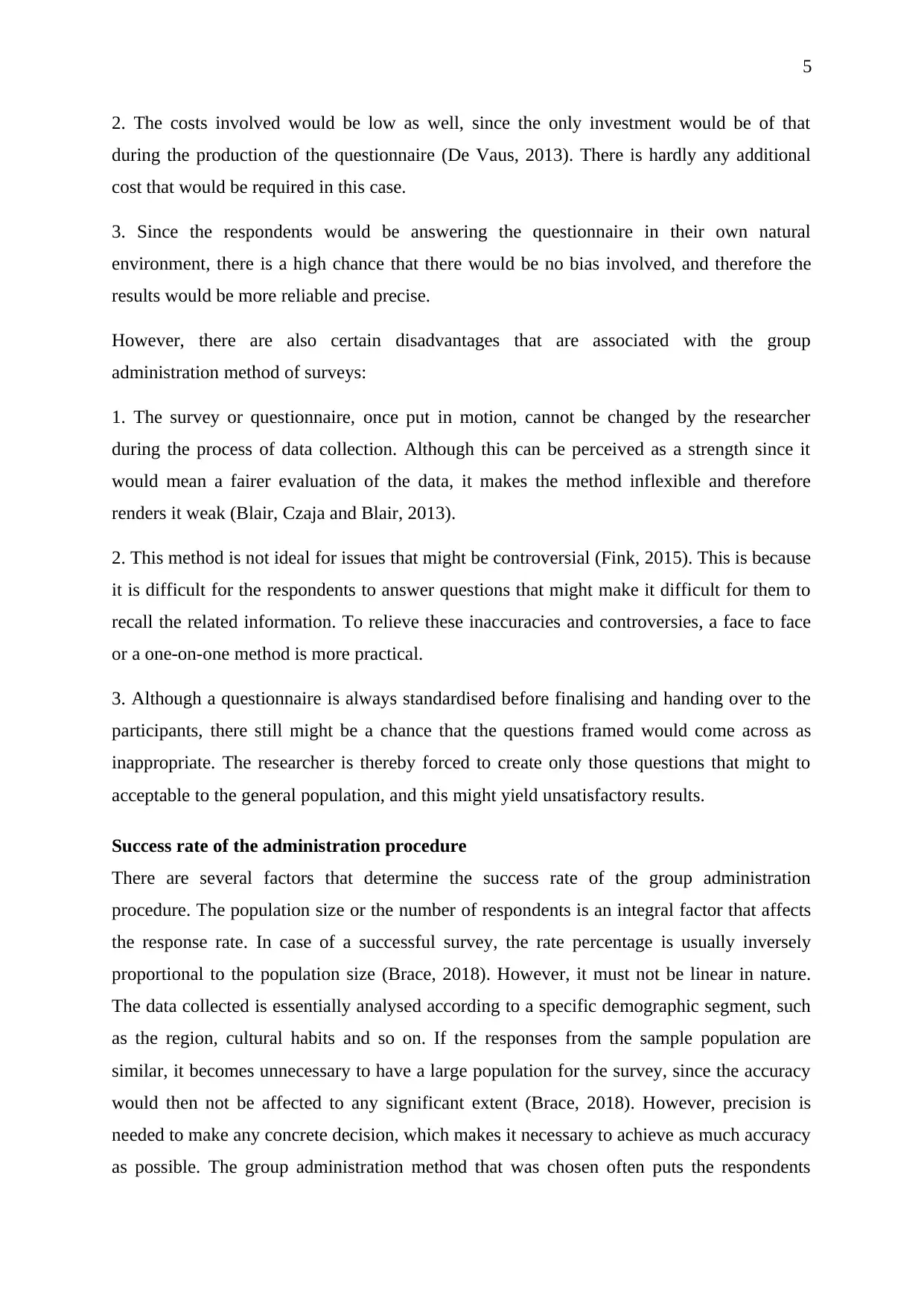
5
2. The costs involved would be low as well, since the only investment would be of that
during the production of the questionnaire (De Vaus, 2013). There is hardly any additional
cost that would be required in this case.
3. Since the respondents would be answering the questionnaire in their own natural
environment, there is a high chance that there would be no bias involved, and therefore the
results would be more reliable and precise.
However, there are also certain disadvantages that are associated with the group
administration method of surveys:
1. The survey or questionnaire, once put in motion, cannot be changed by the researcher
during the process of data collection. Although this can be perceived as a strength since it
would mean a fairer evaluation of the data, it makes the method inflexible and therefore
renders it weak (Blair, Czaja and Blair, 2013).
2. This method is not ideal for issues that might be controversial (Fink, 2015). This is because
it is difficult for the respondents to answer questions that might make it difficult for them to
recall the related information. To relieve these inaccuracies and controversies, a face to face
or a one-on-one method is more practical.
3. Although a questionnaire is always standardised before finalising and handing over to the
participants, there still might be a chance that the questions framed would come across as
inappropriate. The researcher is thereby forced to create only those questions that might to
acceptable to the general population, and this might yield unsatisfactory results.
Success rate of the administration procedure
There are several factors that determine the success rate of the group administration
procedure. The population size or the number of respondents is an integral factor that affects
the response rate. In case of a successful survey, the rate percentage is usually inversely
proportional to the population size (Brace, 2018). However, it must not be linear in nature.
The data collected is essentially analysed according to a specific demographic segment, such
as the region, cultural habits and so on. If the responses from the sample population are
similar, it becomes unnecessary to have a large population for the survey, since the accuracy
would then not be affected to any significant extent (Brace, 2018). However, precision is
needed to make any concrete decision, which makes it necessary to achieve as much accuracy
as possible. The group administration method that was chosen often puts the respondents
2. The costs involved would be low as well, since the only investment would be of that
during the production of the questionnaire (De Vaus, 2013). There is hardly any additional
cost that would be required in this case.
3. Since the respondents would be answering the questionnaire in their own natural
environment, there is a high chance that there would be no bias involved, and therefore the
results would be more reliable and precise.
However, there are also certain disadvantages that are associated with the group
administration method of surveys:
1. The survey or questionnaire, once put in motion, cannot be changed by the researcher
during the process of data collection. Although this can be perceived as a strength since it
would mean a fairer evaluation of the data, it makes the method inflexible and therefore
renders it weak (Blair, Czaja and Blair, 2013).
2. This method is not ideal for issues that might be controversial (Fink, 2015). This is because
it is difficult for the respondents to answer questions that might make it difficult for them to
recall the related information. To relieve these inaccuracies and controversies, a face to face
or a one-on-one method is more practical.
3. Although a questionnaire is always standardised before finalising and handing over to the
participants, there still might be a chance that the questions framed would come across as
inappropriate. The researcher is thereby forced to create only those questions that might to
acceptable to the general population, and this might yield unsatisfactory results.
Success rate of the administration procedure
There are several factors that determine the success rate of the group administration
procedure. The population size or the number of respondents is an integral factor that affects
the response rate. In case of a successful survey, the rate percentage is usually inversely
proportional to the population size (Brace, 2018). However, it must not be linear in nature.
The data collected is essentially analysed according to a specific demographic segment, such
as the region, cultural habits and so on. If the responses from the sample population are
similar, it becomes unnecessary to have a large population for the survey, since the accuracy
would then not be affected to any significant extent (Brace, 2018). However, precision is
needed to make any concrete decision, which makes it necessary to achieve as much accuracy
as possible. The group administration method that was chosen often puts the respondents
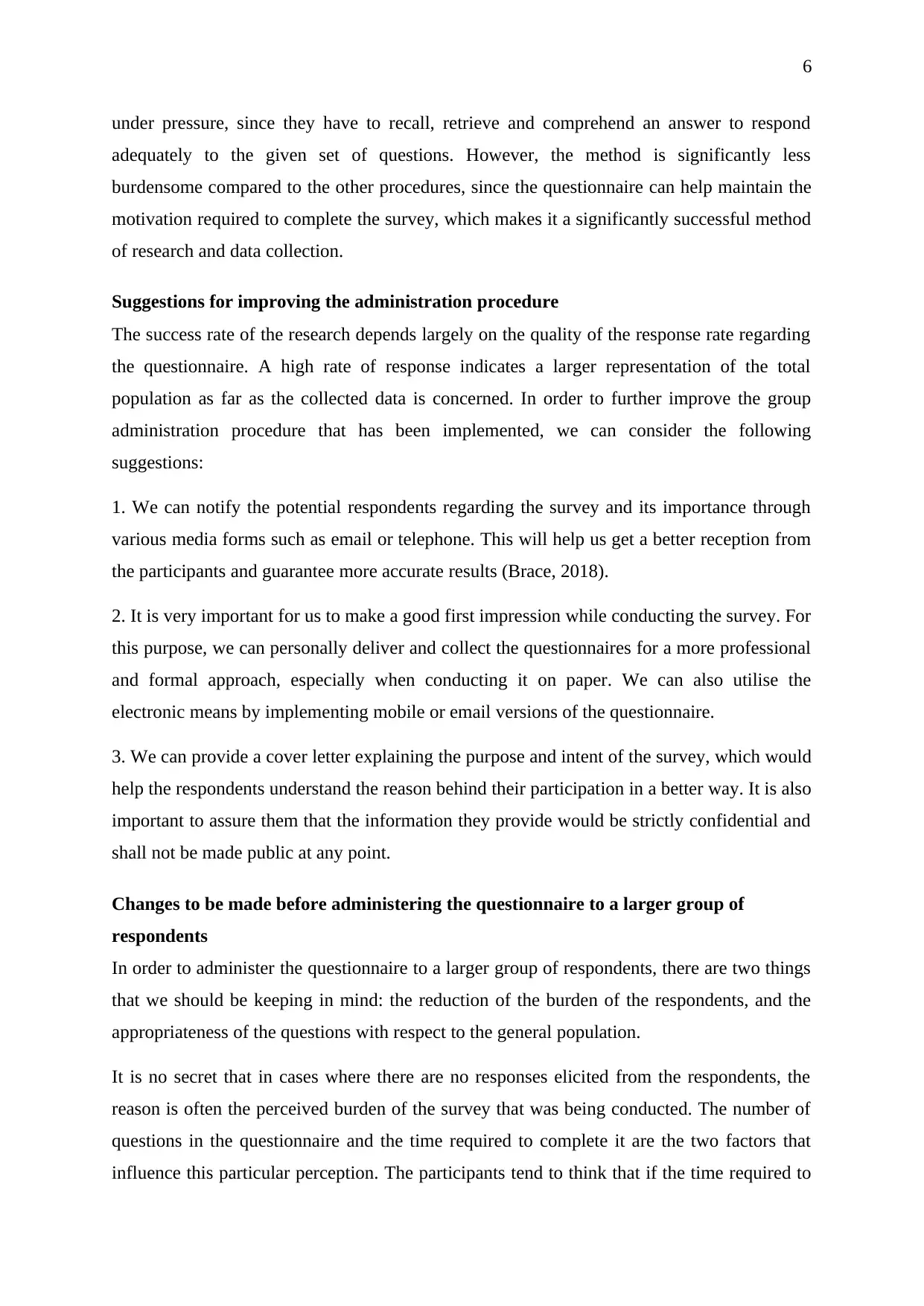
6
under pressure, since they have to recall, retrieve and comprehend an answer to respond
adequately to the given set of questions. However, the method is significantly less
burdensome compared to the other procedures, since the questionnaire can help maintain the
motivation required to complete the survey, which makes it a significantly successful method
of research and data collection.
Suggestions for improving the administration procedure
The success rate of the research depends largely on the quality of the response rate regarding
the questionnaire. A high rate of response indicates a larger representation of the total
population as far as the collected data is concerned. In order to further improve the group
administration procedure that has been implemented, we can consider the following
suggestions:
1. We can notify the potential respondents regarding the survey and its importance through
various media forms such as email or telephone. This will help us get a better reception from
the participants and guarantee more accurate results (Brace, 2018).
2. It is very important for us to make a good first impression while conducting the survey. For
this purpose, we can personally deliver and collect the questionnaires for a more professional
and formal approach, especially when conducting it on paper. We can also utilise the
electronic means by implementing mobile or email versions of the questionnaire.
3. We can provide a cover letter explaining the purpose and intent of the survey, which would
help the respondents understand the reason behind their participation in a better way. It is also
important to assure them that the information they provide would be strictly confidential and
shall not be made public at any point.
Changes to be made before administering the questionnaire to a larger group of
respondents
In order to administer the questionnaire to a larger group of respondents, there are two things
that we should be keeping in mind: the reduction of the burden of the respondents, and the
appropriateness of the questions with respect to the general population.
It is no secret that in cases where there are no responses elicited from the respondents, the
reason is often the perceived burden of the survey that was being conducted. The number of
questions in the questionnaire and the time required to complete it are the two factors that
influence this particular perception. The participants tend to think that if the time required to
under pressure, since they have to recall, retrieve and comprehend an answer to respond
adequately to the given set of questions. However, the method is significantly less
burdensome compared to the other procedures, since the questionnaire can help maintain the
motivation required to complete the survey, which makes it a significantly successful method
of research and data collection.
Suggestions for improving the administration procedure
The success rate of the research depends largely on the quality of the response rate regarding
the questionnaire. A high rate of response indicates a larger representation of the total
population as far as the collected data is concerned. In order to further improve the group
administration procedure that has been implemented, we can consider the following
suggestions:
1. We can notify the potential respondents regarding the survey and its importance through
various media forms such as email or telephone. This will help us get a better reception from
the participants and guarantee more accurate results (Brace, 2018).
2. It is very important for us to make a good first impression while conducting the survey. For
this purpose, we can personally deliver and collect the questionnaires for a more professional
and formal approach, especially when conducting it on paper. We can also utilise the
electronic means by implementing mobile or email versions of the questionnaire.
3. We can provide a cover letter explaining the purpose and intent of the survey, which would
help the respondents understand the reason behind their participation in a better way. It is also
important to assure them that the information they provide would be strictly confidential and
shall not be made public at any point.
Changes to be made before administering the questionnaire to a larger group of
respondents
In order to administer the questionnaire to a larger group of respondents, there are two things
that we should be keeping in mind: the reduction of the burden of the respondents, and the
appropriateness of the questions with respect to the general population.
It is no secret that in cases where there are no responses elicited from the respondents, the
reason is often the perceived burden of the survey that was being conducted. The number of
questions in the questionnaire and the time required to complete it are the two factors that
influence this particular perception. The participants tend to think that if the time required to
⊘ This is a preview!⊘
Do you want full access?
Subscribe today to unlock all pages.

Trusted by 1+ million students worldwide
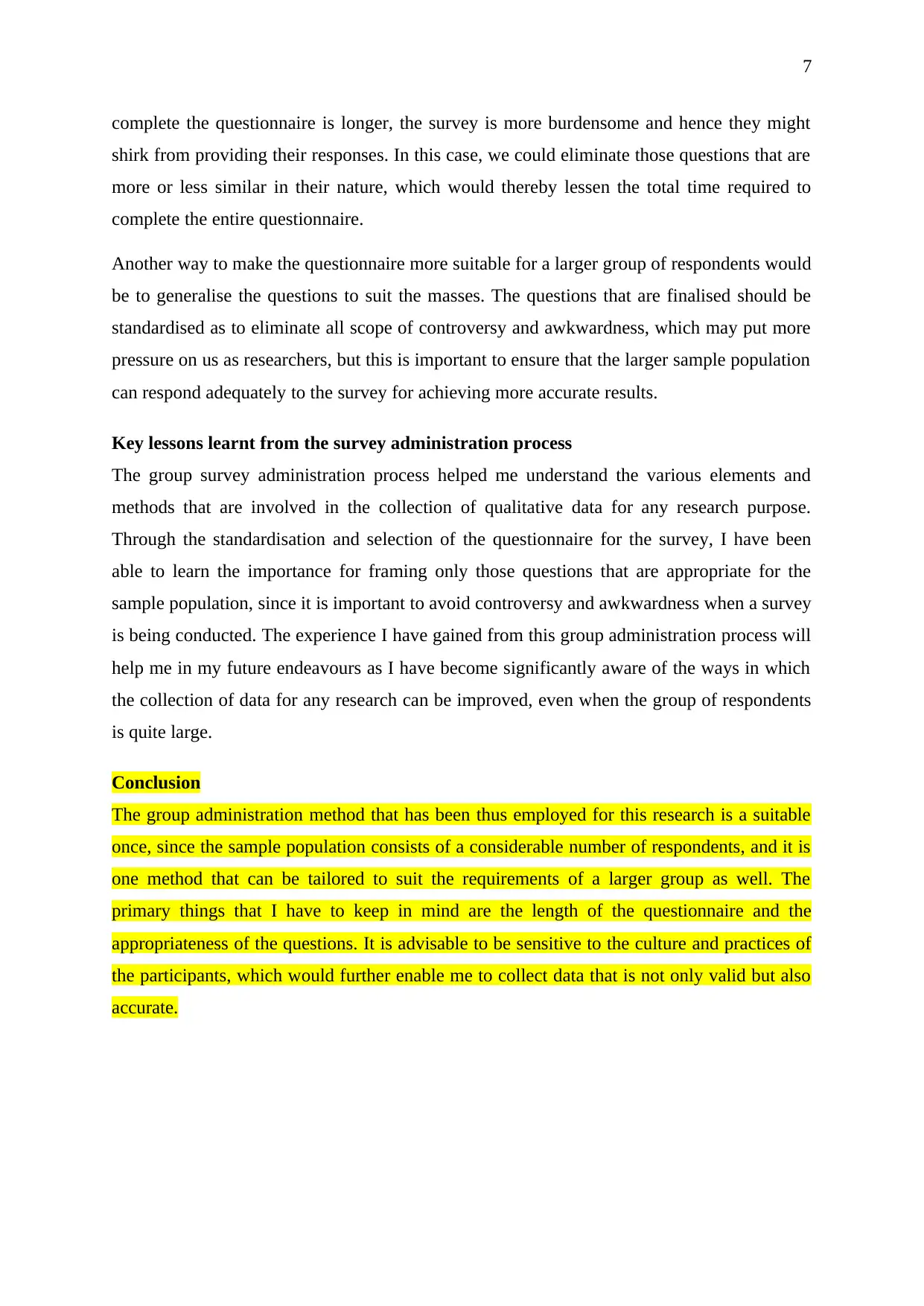
7
complete the questionnaire is longer, the survey is more burdensome and hence they might
shirk from providing their responses. In this case, we could eliminate those questions that are
more or less similar in their nature, which would thereby lessen the total time required to
complete the entire questionnaire.
Another way to make the questionnaire more suitable for a larger group of respondents would
be to generalise the questions to suit the masses. The questions that are finalised should be
standardised as to eliminate all scope of controversy and awkwardness, which may put more
pressure on us as researchers, but this is important to ensure that the larger sample population
can respond adequately to the survey for achieving more accurate results.
Key lessons learnt from the survey administration process
The group survey administration process helped me understand the various elements and
methods that are involved in the collection of qualitative data for any research purpose.
Through the standardisation and selection of the questionnaire for the survey, I have been
able to learn the importance for framing only those questions that are appropriate for the
sample population, since it is important to avoid controversy and awkwardness when a survey
is being conducted. The experience I have gained from this group administration process will
help me in my future endeavours as I have become significantly aware of the ways in which
the collection of data for any research can be improved, even when the group of respondents
is quite large.
Conclusion
The group administration method that has been thus employed for this research is a suitable
once, since the sample population consists of a considerable number of respondents, and it is
one method that can be tailored to suit the requirements of a larger group as well. The
primary things that I have to keep in mind are the length of the questionnaire and the
appropriateness of the questions. It is advisable to be sensitive to the culture and practices of
the participants, which would further enable me to collect data that is not only valid but also
accurate.
complete the questionnaire is longer, the survey is more burdensome and hence they might
shirk from providing their responses. In this case, we could eliminate those questions that are
more or less similar in their nature, which would thereby lessen the total time required to
complete the entire questionnaire.
Another way to make the questionnaire more suitable for a larger group of respondents would
be to generalise the questions to suit the masses. The questions that are finalised should be
standardised as to eliminate all scope of controversy and awkwardness, which may put more
pressure on us as researchers, but this is important to ensure that the larger sample population
can respond adequately to the survey for achieving more accurate results.
Key lessons learnt from the survey administration process
The group survey administration process helped me understand the various elements and
methods that are involved in the collection of qualitative data for any research purpose.
Through the standardisation and selection of the questionnaire for the survey, I have been
able to learn the importance for framing only those questions that are appropriate for the
sample population, since it is important to avoid controversy and awkwardness when a survey
is being conducted. The experience I have gained from this group administration process will
help me in my future endeavours as I have become significantly aware of the ways in which
the collection of data for any research can be improved, even when the group of respondents
is quite large.
Conclusion
The group administration method that has been thus employed for this research is a suitable
once, since the sample population consists of a considerable number of respondents, and it is
one method that can be tailored to suit the requirements of a larger group as well. The
primary things that I have to keep in mind are the length of the questionnaire and the
appropriateness of the questions. It is advisable to be sensitive to the culture and practices of
the participants, which would further enable me to collect data that is not only valid but also
accurate.
Paraphrase This Document
Need a fresh take? Get an instant paraphrase of this document with our AI Paraphraser
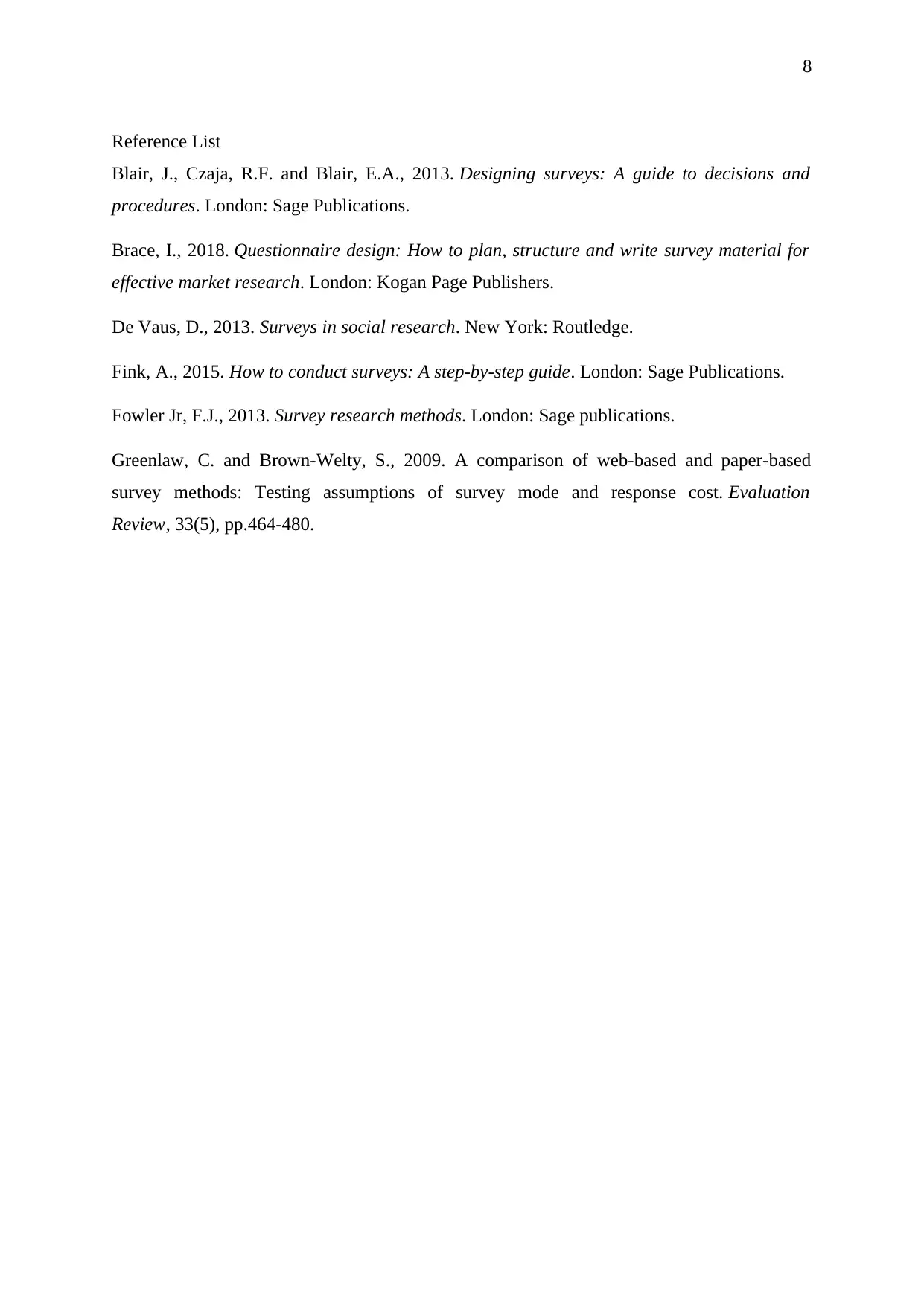
8
Reference List
Blair, J., Czaja, R.F. and Blair, E.A., 2013. Designing surveys: A guide to decisions and
procedures. London: Sage Publications.
Brace, I., 2018. Questionnaire design: How to plan, structure and write survey material for
effective market research. London: Kogan Page Publishers.
De Vaus, D., 2013. Surveys in social research. New York: Routledge.
Fink, A., 2015. How to conduct surveys: A step-by-step guide. London: Sage Publications.
Fowler Jr, F.J., 2013. Survey research methods. London: Sage publications.
Greenlaw, C. and Brown-Welty, S., 2009. A comparison of web-based and paper-based
survey methods: Testing assumptions of survey mode and response cost. Evaluation
Review, 33(5), pp.464-480.
Reference List
Blair, J., Czaja, R.F. and Blair, E.A., 2013. Designing surveys: A guide to decisions and
procedures. London: Sage Publications.
Brace, I., 2018. Questionnaire design: How to plan, structure and write survey material for
effective market research. London: Kogan Page Publishers.
De Vaus, D., 2013. Surveys in social research. New York: Routledge.
Fink, A., 2015. How to conduct surveys: A step-by-step guide. London: Sage Publications.
Fowler Jr, F.J., 2013. Survey research methods. London: Sage publications.
Greenlaw, C. and Brown-Welty, S., 2009. A comparison of web-based and paper-based
survey methods: Testing assumptions of survey mode and response cost. Evaluation
Review, 33(5), pp.464-480.
1 out of 8
Related Documents
Your All-in-One AI-Powered Toolkit for Academic Success.
+13062052269
info@desklib.com
Available 24*7 on WhatsApp / Email
![[object Object]](/_next/static/media/star-bottom.7253800d.svg)
Unlock your academic potential
Copyright © 2020–2025 A2Z Services. All Rights Reserved. Developed and managed by ZUCOL.




